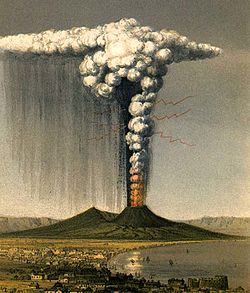 Mount Vesuvius, outside
Mount Vesuvius, outside
Sprenger was the creator of many Cannas, and the Italian Group is named in deference to his production of new cannas. The eruption buried his plants under volcanic ash, destroying hundreds of his best specimens. Some survived, and the establishment attempted to continue, but the following year when Sprenger was offered the role of supervisor of the Kaiser's garden at Achilleion, a garden with a palace on the island of Corfu (Kerkyra), which he accepted and moved much of his plant material to the palace gardens.

 Canna 'Roi Humbert' is an Italian Group cultivar; it has bronze foliage, ovoid shaped, with a spreading habit; distinctive stems, are coloured purple; flowers are open, turning to reflexed, self-coloured tomato-red, staminodes are large, edges irregular, fully self-cleaning; seed is sterile, pollen is sterile; rhizomes are thick, up to 3 cm in diameter, coloured purple; the tillering capability is good. It was confirmed to be a triploid, see Khoshoo, T.N. & Guha, I, Origin and Evolution of Cultivated Cannas, Vikas, India. It has been sold under several synonyms, including C. 'King Humbert', C. '
Canna 'Roi Humbert' is an Italian Group cultivar; it has bronze foliage, ovoid shaped, with a spreading habit; distinctive stems, are coloured purple; flowers are open, turning to reflexed, self-coloured tomato-red, staminodes are large, edges irregular, fully self-cleaning; seed is sterile, pollen is sterile; rhizomes are thick, up to 3 cm in diameter, coloured purple; the tillering capability is good. It was confirmed to be a triploid, see Khoshoo, T.N. & Guha, I, Origin and Evolution of Cultivated Cannas, Vikas, India. It has been sold under several synonyms, including C. 'King Humbert', C. '
 As Sprenger predicted, it did cause a sensation, when sometime later, C. 'King Humbert', as it is known in much of the English speaking world, prided a chimera mutation, which Luther Burbank, California, USA, called Canna 'Yellow King Humbert'. That has gone on to acquire many synonyms of its own, notables being C. 'Cleopatra', C. 'Goldkrone', C. 'Harlequin', C. 'Queen Helena', C. 'Queen of Italy', C. 'Yellow Humbert'. It may be that these are not synonyms at all, but separate mutations; however, our plant material is so mixed that we cannot identify such circumstances.
As Sprenger predicted, it did cause a sensation, when sometime later, C. 'King Humbert', as it is known in much of the English speaking world, prided a chimera mutation, which Luther Burbank, California, USA, called Canna 'Yellow King Humbert'. That has gone on to acquire many synonyms of its own, notables being C. 'Cleopatra', C. 'Goldkrone', C. 'Harlequin', C. 'Queen Helena', C. 'Queen of Italy', C. 'Yellow Humbert'. It may be that these are not synonyms at all, but separate mutations; however, our plant material is so mixed that we cannot identify such circumstances. Canna 'Yellow King Humbert' is a medium sized Italian Group cultivar; foliage green, but often variegated purple markings and occasionally whole leaves purple, oval shaped, spreading habit; oval stems, coloured green + purple; flower clusters are cupped, spotted, colours yellow with red spots, often large red markings and occasionally whole staminodes or even the whole flower red, staminodes are large; seed is sterile, pollen is sterile; rhizomes are long and thin, coloured white and purple; tillering is prolific.
Canna 'Yellow King Humbert' is a medium sized Italian Group cultivar; foliage green, but often variegated purple markings and occasionally whole leaves purple, oval shaped, spreading habit; oval stems, coloured green + purple; flower clusters are cupped, spotted, colours yellow with red spots, often large red markings and occasionally whole staminodes or even the whole flower red, staminodes are large; seed is sterile, pollen is sterile; rhizomes are long and thin, coloured white and purple; tillering is prolific.But the story does not end there, as Canna 'Yellow King Humbert' also has a trick up its sleeve, when it mutates again and produces a new cultivar, similar to its original mutation parent, the first of these secondary mutations was named C. 'Red King Humbert'. Maybe they are all the same plant, but until a scientific analysis of these specimens is performed, we will not know. In the meantime, I intend to enjoy them all. Other names that spring to mind are C. 'Zulu Maiden', C. 'Red Cleopatra'', C. 'Patrick's Red'.
It is recognizably different from C. 'Roi Humbert', having retained the cupped shape flower of C. 'Yellow King Humbert' and the colour is a scarlet red, rather than the tomato-red of the former. It has repeated that trick on several occasions and we now have similar cultivars resulting from this further mutation.

We will never know for certain, but the dates of these events are such that it is highly probable that our favourite Canna chimera is a direct result of the eruption of

